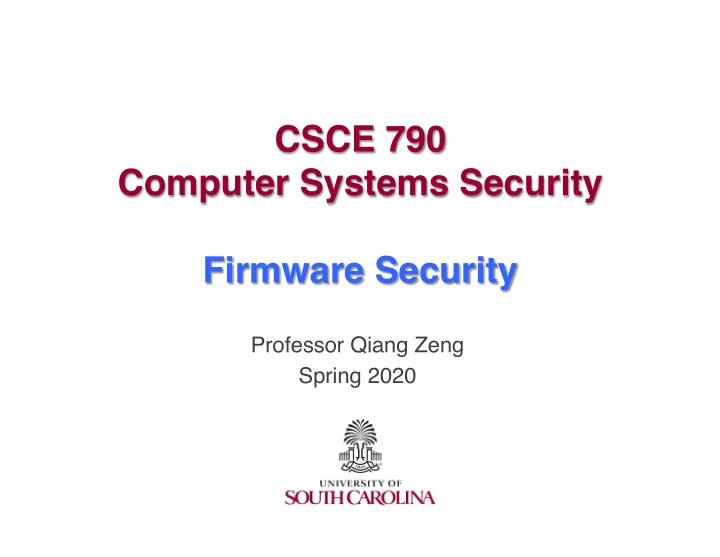

CSCE 790 Computer Systems Security Firmware Security Professor Qiang Zeng Spring 2020
Previous Class • Virus vs. Worm vs. Trojan • Drive-by download • Botnet • Rootkit CSCE 790 – Computer Systems Security 2
Trojan vs. Virus vs. Worm Trojan Virus Worm Self-replicated N Y Y Self-contained Y N Y Relying on exploitation N Maybe (e.g., Y of vulnerabilities scripting viruses) CSCE 790 – Computer Systems Security 3
Previous Class It is possible that an experienced attacker may combine the techniques of viruses and worms (called blended attack). Could you find a concrete example among the famous worm attacks? For example, Melissa (1998) sends itself through emailing, which is the behavior of worms; besides, it also infects local documents by copying itself into them, which is the behavior of viruses There are many such examples that combine worms and viruses: Nimda, Conficker, Stuxnet CSCE 790 – Computer Systems Security 4
Previous Class Does a drive-by download attack always succeed when you open a malicious webpage? No. If there are no vulnerabilities in your browser, drive-by downloads cannot succeed. By design the scripting code (e.g., Javascript code) should not cause harms; it relies on exploiting vulnerabilities of browsers to gain extra privileges to download and install malware. So it is important to keep your browser up to date CSCE 790 – Computer Systems Security 5
Previous Class Describe the main components in a classic botnet structure (1) Botmaster (2) C&C Servers (3) Bots CSCE 790 – Computer Systems Security 6
Firmware • Firmware: special software that is embedded in a hardware device and directly communicates with the device • Almost all electronics devices run firmware – Examples: printers, mobile phones, routers, USB drives, medical implants, TV, cars, and traffic lights Normal Software (optional) Firmware Hardware CSCE 790 – Computer Systems Security 7
Firmware Characteristics • Firmware is typically stored on non-volatile memory, such as EEROM ( E lectrically E rasable P rogrammable R ead- O nly M emory) • Firmware update (called flashing ) is typically rare, and the update process is not foolproof (you may brick it) – E.g., DVD player companies may release new firmware to support new formats of discs. But few would got to update a DVD player – It means that a bug in a device’s firmware may persist during the lifetime of the device CSCE 790 – Computer Systems Security 8
Attack measures • Instead of exploiting a bug in firmware, however, most current hack cases modify firmware to launch attacks • Two cases: – Attack firmware in USB drives – Attack firmware in cars CSCE 790 – Computer Systems Security 9
Case 1: BadUSB [Blackhat2014] CSCE 790 – Computer Systems Security 10
No effective defenses from USB attacks exist CSCE 790 – Computer Systems Security 11
Case 2: Remote Exploitation of Cars [BlackHat’15] • Threat: – Remotely (e.g., from PA to CA) control a 2013-2015 Jeep, Ram, or Dodge • Impact: – Fiat Chrysler recalled 1.4 million cars (07/2015) – Sprint changed its network firewall policy CSCE 790 – Computer Systems Security 12
Terms and Architecture • Terms: – CAN: Controller Area Network. A message bus in vehicle for inter-component communication – ECU: Electronic Control Unit. Each is an embedded system. E.g., engine ECU, transmission ECU, airbag ECU, ABS ECU – Head unit: multimedia system CAN bus Engine ECU WiFi Head unit/ V850/ OMAP chip/ Transmission IOC ECU UConnect Cellular ABS ECU Steering ECU CSCE 790 – Computer Systems Security 13
CAN bus Attack Procedure Engine ECU WiFi Head unit/ V850/ OMAP chip/ Transmission IOC ECU UConnect Cellular ABS ECU Steering ECU 1. Establish network connection with victim car: either guess WiFi password, or scan cars connected to the Sprint cellular network 2. Port scanning and find a vulnerable service listening at some port 3. Exploit the service to login the computer for the head unit 4. Command the head unit to “update” the firmware at V850 5. Now you can send messages to the ECUs to control the car CSCE 790 – Computer Systems Security 14
Talk by Miller and Valasek • https://youtu.be/OobLb1McxnI CSCE 790 – Computer Systems Security 15
References • “BadUSB — On accessories that turn evil”, K Nohl, et al. BlackHat’14 • “Remote Exploitation of An Unaltered Passenger Vehicle”, C Miller and C Valasek. BlackHat’15 CSCE 790 – Computer Systems Security 16
Recommend
More recommend